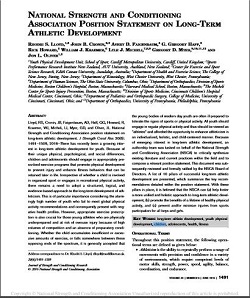NSCA Position Statement on Long-Term Athletic Development
by NSCA
Other
June 2017
The official position statement of the NSCA on long-term athletic development.
Paywall block issue
This article is not configured properly for members or paid content.
isMemberOnly: {{isMemberOnly}} | isPaidContent: {{isPaidContent}}
spc: One or more parts of the product SPC is missing.
Read the full article
View the video
Login to view more
This {{ogType == 'video.other' ? 'video':'article'}} is available with a NSCA membership
or can be purchased for {{prices}}
or can be purchased. Price range: {{prices}}
Price includes membership pricing and promotions
This {{ogType == 'video.other' ? 'video':'article'}} can be purchased for {{prices}}
Price includes membership pricing and promotions
Purchase this {{ogType == 'video.other' ? 'video':'article'}}. Price range: {{prices}}
Price range includes membership pricing and promotions
Essential Reading

There has recently been a growing interest in long-term athletic development for youth. Because of their unique physical, psychological, and social differences, children and adolescents should engage in appropriately prescribed exercise programs that promote physical development to prevent injury and enhance fitness behaviors that can be retained later in life. All youth should engage in regular physical activity and thus should be viewed as “athletes” and afforded the opportunity to enhance athleticism in an individualized, holistic, and child-centered manner.
Related Video
View a related video of President of the NSCA, Dr. Greg Haff, discussing the NSCA's position statement on Long-Term Athletic Development. The Bridge: Long-Term Athletic Development with Dr. Greg Haff
References
Rhodri S. Lloyd, John B. Cronin, Avery D. Faigenbaum, G. Gregory Haff, Rick Howard, William J. Kraemer, Lyle J. Micheli, Gregory D. Myer, and Jon L. Oliver
Journal of Strength and Conditioning Research
Volume 30, Number 6, June 2016
- Privacy Policy
- Your Privacy Choices
- Terms of Use
- Retraction and Correction Policy
- © 2025 National Strength and Conditioning Association